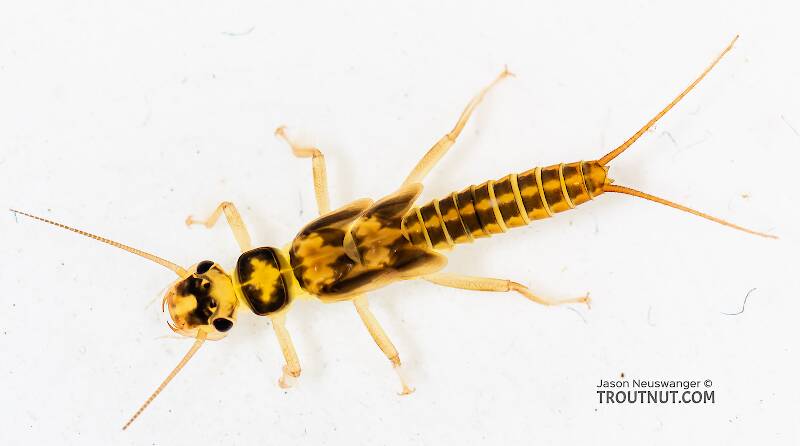
Blue-winged Olives
Baetis
Tiny Baetis mayflies are perhaps the most commonly encountered and imitated by anglers on all American trout streams due to their great abundance, widespread distribution, and trout-friendly emergence habits.


Stonefly Species Osobenus yakimae (Yakima Springflies)
Species Range
Physical description
Most physical descriptions on Troutnut are direct or slightly edited quotes from the original scientific sources describing or updating the species, although there may be errors in copying them to this website. Such descriptions aren't always definitive, because species often turn out to be more variable than the original describers observed. In some cases, only a single specimen was described! However, they are useful starting points.
Male Nymph
Antennal segments about 44, basal segment large, third about twice length of second and half as large as first. Cercal segments about 25; long, erect swimming hairs dorsally on segments. Submental gills absent.
General color yellow with brown markings on head, thorax, and dorsum of abdomen. Ocellar area on head dark brown as in figure 5, this colored area extending forward to clypeus on either side of median ocellus; yellow areas behind rear ocelli and anterior to median ocellus; clypeus yellow. Prothorax brown except for large central yellow area; mesothorax and metathorax brown except for irregular yellow areas centrally. Dorsum of abdomen brown with narrow median yellow stripe; sides and venter of thorax yellow. Antennae, legs, and cerci mostly yellow. Mesosternal ridge pattern similar to that illustrated by Ricker (1952, page 65, figure 36J) for adult except that arms of Y reach
posterior corners of furcal pits.
Maxilla with major and minor tooth, figure 5A; one or two small bristles at base of minor tooth. Tip of maxilla without tufted knob. Mandibles with several teeth, fringe of hairs in patch below teeth on inner margin. Labium, figure 5B, with tips of paraglossae slightly knobbed. Mature male nymph with genitalia partly discernible, figure 5C.
In possessing a dorsal abdominal stripe this nymph closely resembles species in the genus Isoperla.
Description from GBIFthe Global Biodiversity Information Facility
Source: Descriptions Of The Adult Male And Female Genitalia Of The Genus Osobenus Ricker (Plecoptera: Perlodidae)
Descriptions: Male. Pale yellowish brown in color, head with obscure brownish marking, pronotum with a broad yellow stripe (Fig. 1). Tenth tergum deeply cleft, hemitergal lobes elongate, narrowly rounded at apex, bearing ribbed peg-like sensilla basiconica and trichoid sensilla (Figs. 2 – 3). Lateral stylets absent. Epiproct, large, bulbous, triangular in shape (Figs. 4, 5, 10 – 13). Ventral sclerite brown, strap-like, terminating in downturned spine in repose (Figs. 4, 6 – 8, 12); dorsal sclerite brown, terminating between two external patches of stout spinulae and continuing internally to form a coiled sac (Figs. 6, 10 – 12, 14); laterally covered by dense hairs (Figs. 4 – 7). Epiproct with a wide opening on dorsal surface located behind external paired patches of 6 - 7 spines each (Figs. 6 – 9) arising from two longitudinal membranous swellings; opening internally connected to a coiled sac with two basolateral patches of internal spines (Fig. 15).
Female. Subgenital plate parabolic (Fig. 16).
Egg. Typical of the Diploperlini, oval shape, medially with raised ridge, cross section semicircular (Fig. 17). Chorion with visor-like extension covering collar (Fig. 17), chorion with dense punctations, visor coarsely punctate (Fig. 17).
Specimens of the Stonefly Species Osobenus yakimae
1 Nymph

Start a Discussion of Osobenus yakimae
References
- Jewett, S.G. 1955. Notes and descriptions concerning western North American stoneflies (Plecoptera). Wasmann Journal of Biology 13: 145-155.
Stonefly Species Osobenus yakimae (Yakima Springflies)
Species Range
Common Name
Resources
- NatureServe
- Integrated Taxonomic Information System
- Global Biodiversity Information Facility
- Described by Hoppe, G.N. (1938) Plecoptera of Washington. University of Washington Publications in Biology 4, 139–174.

